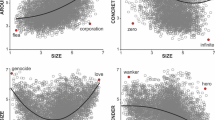Abstract
This research series begins in the theoretical view that human cognition rests in part upon implicit oppositionality. Four experiments are presented, each of which builds on some aspect of the recognition and utilization of oppositionality. Experiment I (34 females, 46 males, in cross-validation) finds that subjects recognize antonymy as readily as synonymy in comparison with a control condition (p<.001). Experiment II demonstrates that subjects rely upon oppositionality to solve a problem as readily as on primacy/recency considerations (p<.001). Experiment III (27 males, 27 females) finds that a subject's ability to recognize the opposite meaning of sentences that have been exposed earlier increases with practice (p<.05). Experiment IV (10 females, 11 males) demonstrates that subjects who are given the set to look for either opposite or nonopposite sentence meanings can make oppositional decisions with equal or greater speed than nonoppositional decisions (p<.001). Implications for psycholinguistic theories are discussed.
Similar content being viewed by others
References
Aristotle. (1952). On memory and reminiscence. In R.M. Hutchins (Ed.),Great books of the western world (Vol. 8, pp. 690–695). Chicago: Encyclopedia Britannica.
Bastian, J. (1961). Associative factors in verbal transfer.Journal of Experimental Psychology, 62, 70–79.
Boring, E.G. (1950).A history of experimental psychology (2nd ed.). New York: Appleton-Century-Crofts.
Brewer, W.F. (1974). There is no convincing evidence for operant or classical conditioning in adult humans. In W.B. Weimer & D.S. Palermo (Eds.),Cognition and the symbolic processes (pp. 1–41). Hillsdale, NJ: Erlbaum.
Brewer, W.F., & Lichtenstein, E.H. (1974). Memory for marked semantic features versus memory for meaning.Journal of Verbal Learning and Verbal Behavior, 13, 172–180.
Carey, S. (1978). The child as word learner. In M. Halle, J. Bresnan, & G.A. Miller (Eds.),Linguistic theory and psychological reality. Cambridge, MA: M.I.T. Press.
Grossman, L., & Eagle, M. (1970). Synonymity, antonymity, and association in false recognition response.Journal of Experimental Psychology, 83, 244–248.
Hampton, J.A., & Taylor, P.J. (1985). Effects of semantic relatedness on same-different decisions in a good-bad categorization task.Journal of Experimental Psychology: Learning, Memory, and Cognition, 11, 85–93.
Kagan, J. (1984).The nature of the child. New York: Basic Books.
Karwoski, T.F., & Schachter, J. (1948). Psychological studies in semantics: III. Reaction times for similarity and differences.Journal of Social Psychology, 28, 103–120.
Kjeldergaard, P.M. (1962). Commonality scores under instructions to give opposites.Psychological Reports, 11, 219–220.
Kreutzer, M.A., Leonard, C., & Flavell, J.H. (1975). An interview study of children's knowledge about memory.Monographs of the Society for Research in Child Development,40(159).
Lamiell, J.T. (1987).The psychology of personality: An epistemological inquiry, New York: Columbia University Press.
Lyons, J. (1977).Semantics (Vol. 1). London: Cambridge University Press.
Mink, W.D. (1963). Semantic generalization as related to word association.Psychological Reports, 12, 59–67.
Osgood, C.E. (1952). The nature and measurement of meaning.Psychological Bulletin, 49, 197–237.
Page, M.M. (1972). Demand characteristics and the verbal operant conditioning experiment.Journal of Personality and Social Psychology, 23, 303–308.
Plato (1952).Sophist. In R.M. Hutchins (Ed.),Great books of the western world (Vol. 7, pp. 551–579). Chicago: Encyclopedia Britannica.
Reese, W. (1980).Dictionary of philosophy and religion. Atlantic Highlands, NJ: Humanities Press.
Richards, I.A. (1967). Introduction. In C. K. Ogden,Opposition: A linguistic and psychological analysis (pp. 7–13). Bloomington: Indiana University Press.
Ryan, J.J., III (1960). Comparison of verbal response transfer mediated by meaningfully similar and associated stimuli.Journal of Experimental Psychology, 60, 408–415.
Schvaneveldt, R.W., Durso, F.R., & Mukherji, B.R. (1982). Semantic distance effects in categorization tasks.Journal of Experimental Psychology: Learning, Memory, and Cognition, 8, 1–15.
Siipola, E., Walker, W.N., & Kolb, D. (1955). Task attitude in word association, projective and nonprojective.Journal of Personality, 23, 441–459.
Trier, J. (1931).Der deutsche wortschatz im sinnbezirk des verstandes. Heidelberg: Winter.
Umemoto, T. (1959). Japanese studies in verbal learning and memory.Psychologia, 2, 1–19.
Weiss-Shed, E. (1973). Synonyms, antonyms and retroactive inhibition with meaningful materials.Psychological Reports, 33, 459–465.
Westcott, M. (1981). Direct and dialectical semantics of human freedom.Etcetera: A Review of General Semantics, 38, 64–75.
Wickens, D.D., & Cermack, L.S. (1967). Transfer effects of synonyms and antonyms in a mixed and unmixed list design.Journal of Verbal Learning and Verbal Behavior, 6, 832–839.
Winer, B.J. (1971).Statistical principles in experimental design (2nd ed.). New York: McGraw-Hill.
Wyer, R.S. & Carlston, D.E. (1979).Social cognition, inference, and attribution. Hillsdale, NJ: Erlbaum.
Author information
Authors and Affiliations
Rights and permissions
About this article
Cite this article
Rychlak, J.F., Barnard, S., Williams, R.N. et al. The recognition and cognitive utilization of oppositionality. J Psycholinguist Res 18, 181–199 (1989). https://doi.org/10.1007/BF01067781
Accepted:
Issue Date:
DOI: https://doi.org/10.1007/BF01067781




